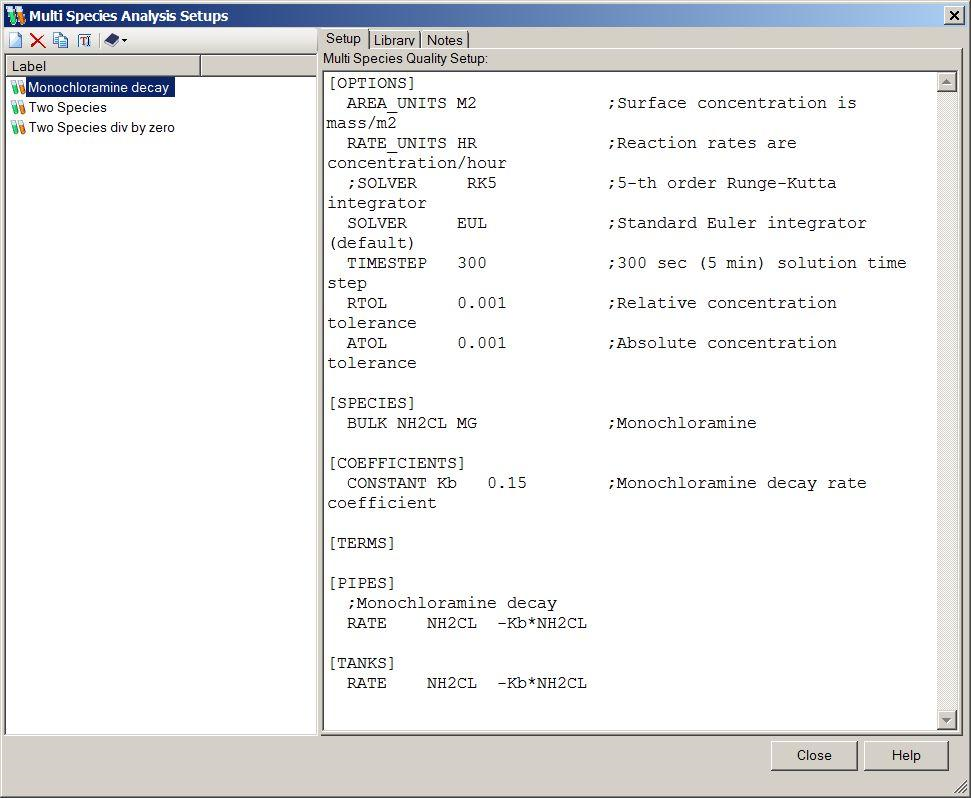Multi-Species Water Quality Analysis
Using constituent analysis, a user can track a single constituent through a water distribution system, provided the constituent behaved according to one of the kinetic models (e.g. first order decay). However, some constituents cannot be modeled this way because they are involved in significant multi-species reactions or their kinetics do not fit one of the existing models. To handle these cases, HAMMER CONNECT provides Multi-species Analysis, based on the EPANET-MSX model with a HAMMER CONNECT user interface.
In order to use multi-species analysis in HAMMER CONNECT, in addition to the usual EPS input, the user must provide:
- Generic options such as water quality time step size
- Species name and mass units
- Reaction rate coefficients either globally or pipe by pipe
- Rate and equilibrium equations for pipes and tanks
- Sources of each species and relevant time patterns
- Initial concentration of species
- Reporting options
These values are entered as text in the Multi-species Analysis Setup and Multi-Species Model Configuration using the syntax described below. For a multi-species scenario, the calculation options are set to Multi-species analysis (see Multi-species Analysis Setup and Multi-species Model Configuration). The distinction between Setup and Configuration is that setup contains values describing kinetics and can be used with any model while configuration contains values for sources and overrides that are specific to the current model.
The data for a multi-species analysis is divided into sections as described below:
[TITLE] adds a descriptive title to the data set
[OPTIONS] sets the values of computational options
[SPECIES] names the chemical species being analyzed
[COEFFICIENTS] names the parameters and constants used in chemical rate and equilibrium expressions
[TERMS] defines intermediate terms used in chemical rate and equilibrium expressions
[PIPES] supplies the rate and equilibrium dynamics in pipes expressions that govern species
[TANKS] supplies the rate and equilibrium dynamics in storage tanks expressions that govern species
[SOURCES] identifies input sources (i.e., boundary conditions) for selected species
[QUALITY] supplies initial conditions for selected species throughout the network
[PARAMETERS] allows parameter values to be assigned on a pipe by pipe basis
[PATTERNS] defines time patterns used with input sources
[REPORT] specifies reporting options
The values for most of these sections are entered under model setup while the sections on Sources, Quality and Parameters are model specific and are described under model configuration.
This help topic provides the steps to run a multi-species analysis in HAMMER CONNECT. For more detailed background and theory, the user is referred to the EPANET-MSX manual.
Setup
To enter the data for a multi-species run, the user must create a multi-species setup by selecting Component > Multi-Species Analysis Setups. Pick New to create a setup.
The user can also Delete, Copy, Rename or Import/Export setups from a library.
The exact syntax for the setup is provided in the help topic Multi-species Analysis Setup.
Configuration
Within the calculation options, the user identifies model specific properties for a Multi-species analysis.
The exact syntax for the setup is provided in the help topic Multi-species Analysis Setup.
Calculation Options
To run a multi-species analysis, the user must set the Calculation Type in the Calculation Options to Multi-Species Analysis.
This opens up a category at the bottom of the calculation options where the user Multi-Species Setup to use from the list of those created above and the Model Configuration for this model.
Results
The results of a multi-species analysis run are available using the property grid, graphing, annotation, color coding just as any other HAMMER CONNECT results.


